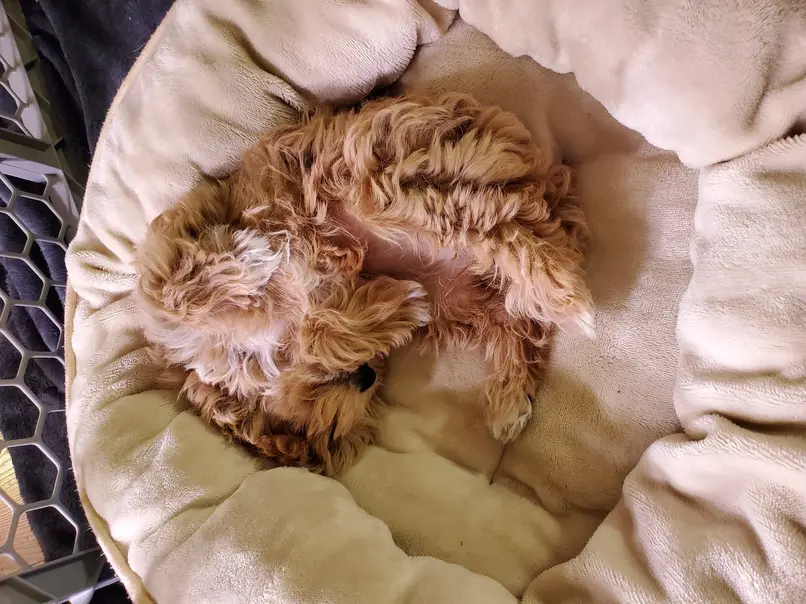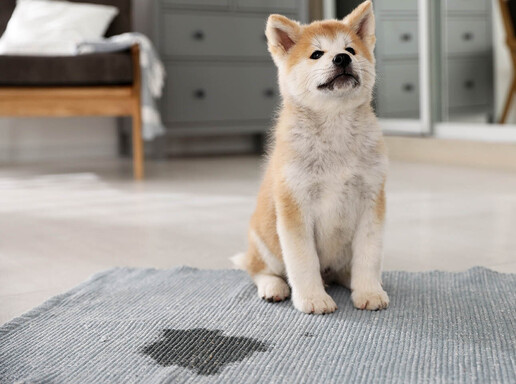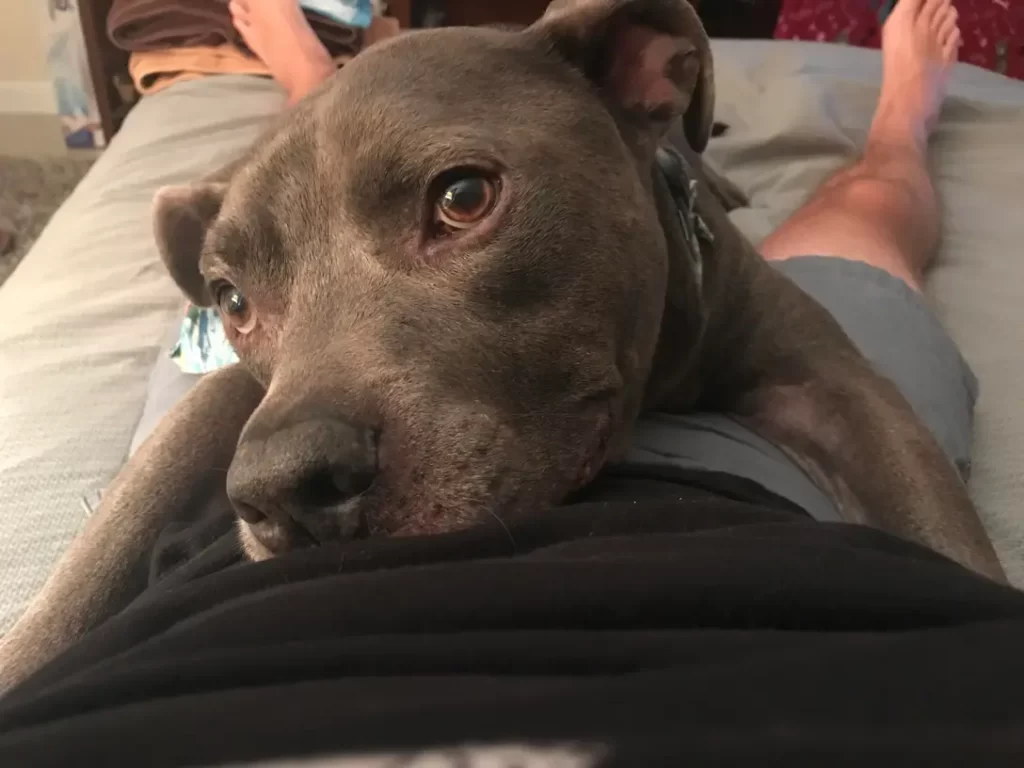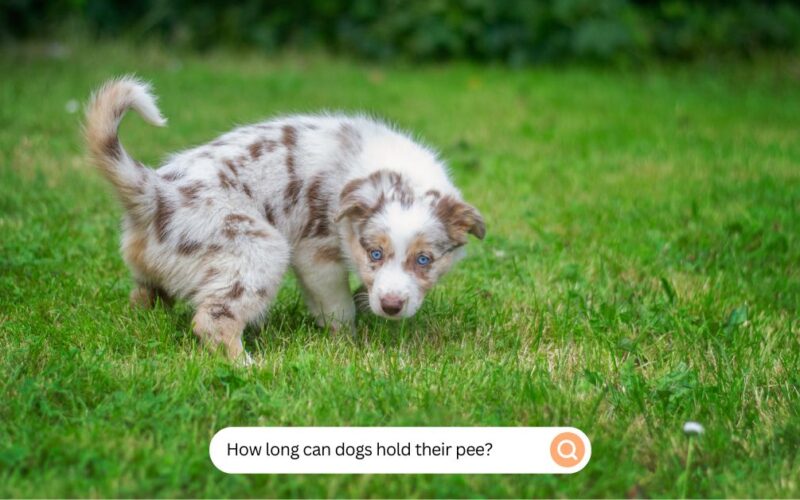About the Author: Introducing Dr. Adriana Luis, our Senior Content Editor at MyPetDoggie and also Veterinarian (MVZ). Kerry devotes most of her time to penning enlightening pieces about pet health, providing invaluable knowledge to pet owners globally. As the director of our Veterinary Content Team, she ensures the accuracy and comprehensiveness of our content, thereby making pet care accessible and understandable for everyone.
Did you know that dogs have an awesome ability to hold back their pee? It’s true! These curious creatures have remarkable bladder control that enables them to hold it for extended periods.
However, the exact time on how long can dogs hold their pee varies depending on factors like age, size, and overall health. Generally, adult dogs can hold their pee for around 6 to 8 hours, while puppies may need more frequent potty breaks.
Small dog breeds have smaller bladders which can highly influence their ability to hold their pee. They may need to go outside to relieve them more often than big dogs. Additionally, certain medical conditions or medications can also influence a bladder’s control and increase their need for bathroom breaks.
Now, let’s dive deeper into the fascinating world of canine bladder control!
How Long Can Dogs Hold Their Pee?
A general study suggests that older dogs, aged 7 years or older may only be able to hold their urine for 2-4 hours. Dogs between 1 to 7 years old can easily hold their urine for 6 to 8 hours. While puppies can hold their pee for about 2-3 hours.
While puppies may need frequent potty breaks. Those little ones just can’t hold it as long as the big dogs.

Here is a quick guide about dogs and their ability to hold their pee as they age from a puppy to a senior dog:
Puppy:
Puppies have smaller bladders, hence the ability to hold their pee is also less compared to the big dogs. They just simply can’t hold it in as long! So, as a proud puppy parent, be prepared for more frequent potty breaks throughout the day. Puppies may need to go outside every 2-3 hours to relieve themselves.
1-7 year old dogs (Adult dogs):
When it comes to adult dogs between 1 and 7 years old, their ability to hold back their pee can vary depending on factors like age, size, and overall health. But, their ability is at its best. Generally, adult dogs can hold their urine for 6-8 hours.
7 years or older dogs (Senior dogs):
As dogs enter their senior years at 7 or older, their ability to hold back their urine usually deteriorates. Just like humans, getting older can affect bladder control in dogs. They experience weaker muscles and decreased bladder capacity, leading to more frequent bathroom breaks.
It is highly important to be watchful and attentive to your senior dog’s needs and provide them with the required opportunities to relieve themselves. Taking them out for bathroom breaks more frequently, such as every 4 to 6 hours, can help in preventing accidents and discomfort.
Some dogs may have a little more bladder control and can hold their pee for a longer time, while others may need more frequent bathroom breaks. It is all about understanding your furry friend’s specific abilities and providing them with ample opportunities to relieve themselves regularly.
Now, let’s dive into the details of a puppy’s capability of holding their pee!
How Long Can Puppies Hold Their Pee?
When it comes to puppies and their ability to control their need for peeing, it’s important to keep in mind that their bladder control varies depending on their age and size. Generally, puppies can hold their pee for about one hour for every month of their age. So, a 2-month-old puppy can typically hold it for about 2 hours, while a 3-month-old can hold it for around 3 hours.

As puppies grow older, the capacity of their bladder increases, and they slowly start gaining better control. By the time they reach 4 to 6 months of age, most puppies can hold their pee for about 4 to 6 hours during the day.
However, if your puppy is at 6 months of age, it is essential to give them bathroom breaks every 4 hours rather than 6 to keep them comfortable. Providing frequent potty breaks to prevent accidents and reinforce their potty training.
It is extremely crucial to remember that these are just a few rough estimates, and individual puppies may have different and much more frequent needs for bathroom breaks. Some pups may need to go more often, especially after meals, playtime, or naps.
Remember, consistency and patience are key to effective potty training. Establishing a proper routine, rewarding your pup when they show good behavior, and providing ample opportunities for potty breaks will help your pup develop better bladder control.
Puppy Pee Control Chart (In Months)
Did you know that as puppies are born and start growing older, their ability to hold their pee gradually improves at a noticeable rate? At around 4 to 6 months of age, most puppies start developing better control over their bladder and can hold their pee for longer periods.
Here is a table to help you understand how the ability to hold their pee increases as they age:
| Age | How Often They Need To Pee | How Long Can They Hold it |
|---|---|---|
| 2 months old | Every two hours | 2 to 3 hours |
| 3 months old | Every four hours | 3 to 4 hours |
| 4 months old | Every five hours | 4 to 5 hours |
| 5 months old | Every six hours | 5 to 6 hours |
| 6 months old | Every eight hours | 6 to 8 hours |
| 7 months old | Every six to eight hours | 8 hours is the maximum time they can hold it during the day. |
Holding pee back can seem like an awesome idea when you can not take your dogs outside but, it comes with its drawbacks. Let me explain!
What Happens When a Dog Holds Pee Too Long?
When you make your fur baby hold in their pee for too long, it can actually pose some serious health risks. Even though they might seem to be physically capable of holding it, keeping it in for extended periods can increase the chances of urinary tract infections, urinary crystals, and stones.

It is important to prevent such health problems from happening by properly recognizing them and taking care accordingly. Following this, let me give you a brief list of risks that holding pee for too long can pose in dogs.
Increased risk of urinary tract infections:
Holding pee for extended hours can increase the risk of urinary tract infections (UTIs). Bacterias can multiply in the bladder when urine is not regularly passed out, leading to severe discomfort, pain, and potential health problems.
Bladder and kidney issues:
holding pee for extended periods can put a strain on the bladder and kidneys. As time passes, this can easily lead to a weakened bladder muscle tone and a reduced bladder capacity, making it much harder for the dog to fully empty their bladder when they do finally let go.
Increased risk of accidents:
If a dog constantly holds their pee for long hours, they may have to struggle to hold it in when they really need to. This can result in pee accidents inside the house, which can be frustrating for both the dog and their owner.
Behavioral issues:
Dogs that are forced to hold back their pee for extended periods of time may develop behavioral issues related to their potty habits. They may become more anxious, and restless, or exhibit signs of discomfort or pain when they feel the need to relieve themselves.
Increased water consumption:
Dogs who hold their pee for too long may also need to drink more water to make up for the discomfort or dehydration caused by holding it in. This can lead to an increased need for urination and potentially exacerbate the issue.
To prevent this from happening, you should take your dog on regular bathroom breaks to relieve themselves. Holding their urine is not beneficial for their health at all!
Have you ever heard that there are different reasons that a dog can pee? It’s not a joke!
How Does Size Impact Urine Holding?
Small dogs have limited ability to control their bladder, so they can not hold as much urine as their larger counterparts. As a result, they need to relieve themselves more often throughout the day. But that’s not all! Another interesting thing about small dogs is that their higher metabolism leads to an increased amount of waste production.

Smaller dogs or puppies are mostly full of energy hence they generate more waste because of their body size. Their little bodies are working hard and producing relatively more waste, which means they need frequent bathroom breaks to keep things flowing smoothly.
And here is another fascinating tidbit: smaller-sized dogs have a high tendency to mark their territory more often. They use their pee as a way of communicating with other dogs and to mark their presence in an area. This instinctual behavior makes them pee more frequently than dogs of bigger size, who may rely on different ways of communicating.
So, now you know how the combination of smaller bladders, higher metabolism, and marking behavior all contribute to small dogs needing to relieve themselves more frequently. It is truly amazing how these factors come together to shape their bathroom habits!
How Long Can A Dog Hold Its Bladder Overnight?
When it comes to holding their bladder overnight, it depends on various factors. First, the age and size of the dog play an important part. Generally, adult dogs can control their bladder for about 8 to 10 hours overnight, while puppies and smaller breeds may need frequent bathroom trips.
Another factor that affects their bladder control is their overall health and hydration levels. If a dog is well hydrated and doesn’t have any underlying health issues, they may be able to hold their bladder for longer periods. However, it’s always a better idea to provide regular bathroom breaks, preventing any discomfort or accidents.
Lastly, It is important to note that every dog is unique and their ability to hold their pee is different. Some dogs may have better bladder control than others and It is always a great idea to consult with your veterinarian if you have any specific concerns about your dog’s bathroom habits.
Well, even if your dog has great control over their bladder, they still need to relieve themselves a few times, right? And what happens if you’re not around for that? Let’s see what you can do to take care of their bathroom needs even when you’re not home enough!
What To Do If You Are Not Home Enough?
Having fur babies and not being able to give them the love and attention they deserve can be a stressful situation. But don’t worry, there are several things you can do to ensure your dog’s well-being even when you are away.

First, you can consider contacting a trusted neighbor, family member, or friend who can check in on your dog when you are gone. They can spend some quality time with them and take them outside for a regular walk or bathroom breaks.
Secondly, you might want to sign up for the option of doggy daycare. These facilities are designed to provide a safe and engaging environment for dogs. Your furry pal can socialize with other dogs, engage in some stimulating playtime, and receive the care and attention they need during the day.
Lastly, consider setting up a designated area somewhere in your home where your dog can stay comfortably while you are gone. Make sure it’s safe, and secure, and has everything your dog needs, such as water, food, engaging toys, and a cozy bed.
Remember, every dog is different and their way of care and attention may differ too but, while it can be a challenging task if you are not home, with proper planning and support, you can ensure they stay engaged and well cared for.
How To Train A Dog To Pee Outside
How difficult can it be to potty train your dog? Well, it’s not hard at all! With my amazing guide about training your dog to pee outside, it’s a breeze!
- Establish a consistent schedule for bathroom breaks, taking your dog outside first thing in the morning, after meals, and before bedtime.
- Choose a designated potty area and use Dog Rocks that will encourage your dogs to pee on a single spot.
- Be patient and attentive, watching for signs like sniffing or circling, and take your dog out immediately.
- Clean up accidents indoors promptly to remove odors that might attract your dog to pee in the same spot.
Remember, every dog is different, and the training process may take some time. Be patient, stay positive, and celebrate each successful outdoor pee as a step towards a cleaner home and success.
Health Conditions That Cause Increased Urination in Dogs
There are a lot of health issues that can influence the ability of a dog’s bladder to produce their pee. As Dr. Michele K. DVM said, “Reasons for dogs to start urinating more frequently include urinary tract infections, diabetes, kidney or liver disease, or incontinence. It would be best to have your dog seen by a veterinarian as soon as possible..”
Source: https://wagwalking.com/condition/frequent-urination
Here are some most common factors of increased urination:
Diabetes Mellitus:
This particular condition affects the body’s ability to correctly regulate blood sugar levels and can lead to an increased need for water that eventually leads to increased urination.
Diabetes Insipidus:
This is a rare condition that affects the body’s ability to conserve water, leading to excessive urination and thirst.
Kidney Disease:
Damage to the kidneys can harm their ability to concentrate urine, leading to an increased amount of urine production.
Urinary Tract Infections (UTIs):
Infections in the urinary tract can cause more frequent need for urination and also cause discomfort in dogs.
Cushing’s Syndrome (Hyperadrenocorticism):
this is an endocrine disorder that can cause increased thirst and urination due to excess cortisol production.
Liver Disease:
Certain liver conditions can influence the body’s fluid balance and lead to an increased need for urination.
Hypercalcemia:
Elevated levels of calcium in the blood can also lead to increased thirst and urination.
Pyometra:
this is a serious infection of the uterus that can cause increased urination, among other symptoms.
Certain Medications:
Some medications, such as diuretics, can increase urine production in dogs. If you notice an abnormal amount of urine production in your dog, consider the side effects of their medical treatment and if they take any medications.
So,
I hope the answer to the question of how long can dogs hold their pee is answered.
Actually, when it comes to dogs and their need for peeing, there are a few things you should keep in mind.
First, it is highly important to understand that dogs have specific urination needs based on their age, size, and health. Puppies, for example, may need more frequent potty breaks as compared to adult dogs.
Some specific health conditions, such as diabetes mellitus, diabetes insipidus, kidney disease, and urinary tract infections, can lead to increased urination in dogs. If you notice your dog peeing more frequently than usual, it’s important to consult with a veterinarian for proper diagnosis and treatment.
Additionally, it’s crucial to have a consistent potty schedule for your dog and provide them with ample opportunities to relieve themselves outside in their designated area.
Proper training and positive reinforcement can help reinforce good peeing habits. Keep in mind to always be patient and understand your furry friend’s specific needs as they navigate their bathroom needs.






